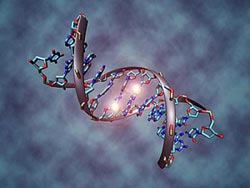Epigenetics alters genes in rheumatoid arthritis

In this artist's rendering, a DNA molecule is methylated on both strands at the center cytosine. DNA methylation plays an important role in epigenetic gene regulation, and is involved in both normal development and in cancer. Credit: UC San Diego School of Medicine<br>
A research team at the University of California, San Diego – led by Gary S. Firestein, professor in the Division of Rheumatology, Allergy and Immunology at UC San Diego School of Medicine – investigated a mechanism usually implicated in cancer and in fetal development, called DNA methylation, in the progression of rheumatoid arthritis (RA). They found that epigenetic changes due to methylation play a key role in altering genes that could potentially contribute to inflammation and joint damage. Their study is currently published in the online edition of the Annals of the Rheumatic Diseases.
“Genomics has rapidly advanced our understanding of susceptibility and severity of rheumatoid arthritis,” said Firestein. “While many genetic associations have been described in this disease, we also know that if one identical twin develops RA that the other twin only has a 12 to 15 percent chance of also getting the disease. This suggests that other factors are at play – epigenetic influences.”
DNA methylation is one example of epigenetic change, in which a strand of DNA is modified after it is duplicated by adding a methyl to any cytosine molecule (C) – one of the 4 main bases of DNA. This is one of the methods used to regulate gene expression, and is often abnormal in cancers and plays a role in organ development.
While DNA methylation of individual genes has been explored in autoimmune diseases, this study represents a genome-wide evaluation of the process in fibroblast-like synoviocytes (FLS), isolated from the site of the disease in RA. FLS are cells that interact with the immune cells in RA, an inflammatory disease in the joints that damages cartilage, bone and soft tissues of the joint.
In this study, scientists isolated and evaluated genomic DNA from 28 cell lines. They looked at DNA methylation patterns in RA FLS and compared them with FLS derived from normal individuals or patients with non-inflammatory joint disease. The data showed that the FLS in RA display a DNA methylome signature that distinguishes them from osteoarthritis and normal FLS. These FLS possess differentially methylated (DM) genes that are critical to cell trafficking, inflammation and cell–extracellular matrix interactions.
“We found that hypomethylation of individual genes was associated with increased gene expression and occurred in multiple pathways critical to inflammatory responses,” said Firestein, adding that this led to their conclusion: Differentially methylated genes can alter FLS gene expression and contribute to the pathogenesis of RA.
Additional contributors include Kazuhisa Nakano and David L. Boyle, UCSD Department of Medicine; and John W. Whitaker and Wei Wang, UCSD Department of Chemistry and Biochemistry.
This project was supported by grant number UL1RR031980 from the National Institutes of Health's National Center for Advancing Translational Science.
NexDx, Inc. licensed the technology from UC San Diego and provided informatics support for this study. Gary S. Firestein and Wei Wang are on the Scientific Advisory Board of NexDx, Inc.
Media Contact
More Information:
http://www.ucsd.eduAll latest news from the category: Life Sciences and Chemistry
Articles and reports from the Life Sciences and chemistry area deal with applied and basic research into modern biology, chemistry and human medicine.
Valuable information can be found on a range of life sciences fields including bacteriology, biochemistry, bionics, bioinformatics, biophysics, biotechnology, genetics, geobotany, human biology, marine biology, microbiology, molecular biology, cellular biology, zoology, bioinorganic chemistry, microchemistry and environmental chemistry.
Newest articles

Properties of new materials for microchips
… can now be measured well. Reseachers of Delft University of Technology demonstrated measuring performance properties of ultrathin silicon membranes. Making ever smaller and more powerful chips requires new ultrathin…

Floating solar’s potential
… to support sustainable development by addressing climate, water, and energy goals holistically. A new study published this week in Nature Energy raises the potential for floating solar photovoltaics (FPV)…

Skyrmions move at record speeds
… a step towards the computing of the future. An international research team led by scientists from the CNRS1 has discovered that the magnetic nanobubbles2 known as skyrmions can be…





















